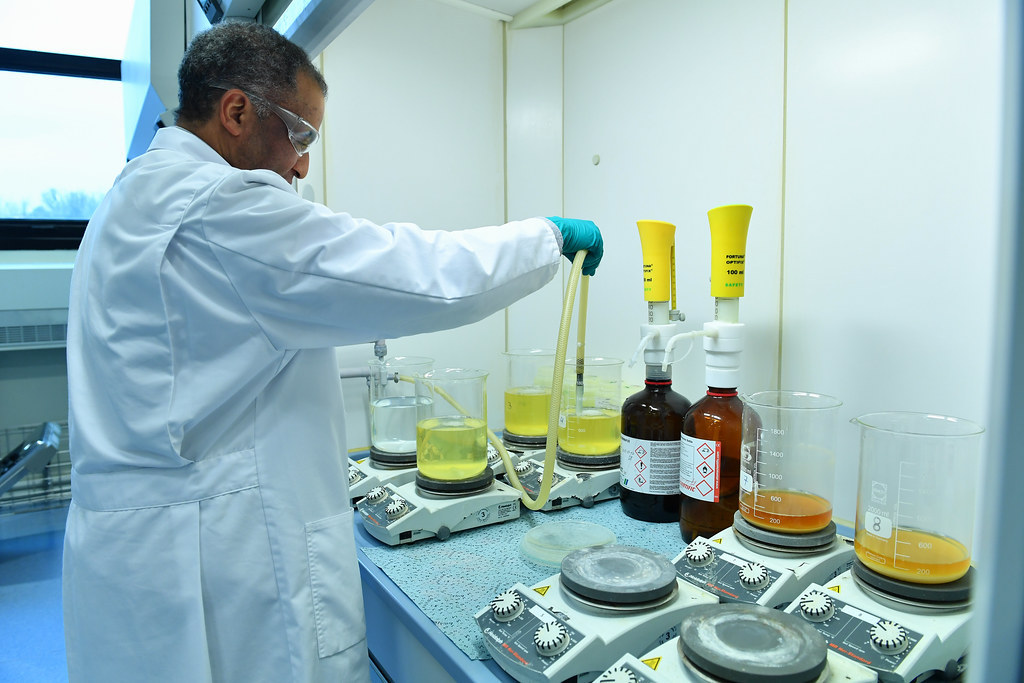Chemical processes are fascinating and often have surprising or seemingly paradoxical outcomes. Here are ten chemical processes that are mind-bending in their complexity, unexpected outcomes, or unusual behavior:
1. The Belousov-Zhabotinsky (BZ) Reaction
- What It Is: A classic example of a non-equilibrium, oscillating chemical reaction, the BZ reaction produces periodic changes in color, typically from colorless to red or blue.
- Why It’s Mind-Bending: The reaction shows spontaneous oscillations in concentration of reactants and products without any external periodic force. This behavior—reminiscent of biological rhythms—makes it a stunning example of chemical “clock” behavior.
2. Photosynthesis
- What It Is: Plants and some bacteria convert sunlight, carbon dioxide, and water into glucose and oxygen.
- Why It’s Mind-Bending: The efficiency of photosynthesis and its intricate series of reactions (including the light-dependent and light-independent cycles) is astounding. The process also involves quantum effects like quantum coherence in photosynthetic complexes, which allow energy transfer with near-perfect efficiency.
3. The Synthesis of Fullerenes (Buckyballs)
- What It Is: The formation of spherical molecules made entirely of carbon, often in the form of C60, which resemble soccer balls.
- Why It’s Mind-Bending: Fullerenes exhibit fascinating chemical and physical properties, including superconductivity and their ability to encapsulate other molecules. Their discovery opened new avenues in nanotechnology, where these tiny molecules could one day revolutionize materials science and medicine.
4. The Haber-Bosch Process
- What It Is: A method for synthesizing ammonia from nitrogen and hydrogen gases under high pressure and temperature.
- Why It’s Mind-Bending: The fact that nitrogen, an inert molecule in the atmosphere, can be transformed into a highly reactive substance (ammonia) under such harsh conditions is an extraordinary feat of chemistry. This process is responsible for producing fertilizers that sustain much of the global population.
5. Chiral Catalysis (Asymmetric Synthesis)
- What It Is: The creation of molecules that have “handedness” (chirality), where the orientation of atoms cannot be superimposed on their mirror image.
- Why It’s Mind-Bending: Chiral molecules have immense importance in pharmaceuticals, where one chirality can be therapeutic and the other toxic. The ability to selectively create one enantiomer (chirality) of a compound using catalysts is both a breakthrough and a deep mystery in how molecular interactions work.
6. Polymerization of Polymers
- What It Is: The process in which small molecules (monomers) are chemically bonded to form large chains (polymers), like the synthesis of polyethylene, polystyrene, or DNA.
- Why It’s Mind-Bending: The variety and complexity of polymers—especially biopolymers like DNA or proteins—are staggering. DNA, in particular, is made of only four nucleotides, yet it encodes all the genetic information for life, showcasing how simple units can combine to create life’s most intricate molecules.
7. Titration and pH Shifts
- What It Is: The process of slowly adding a titrant to a solution to measure its concentration or neutralize an acid/base.
- Why It’s Mind-Bending: The dramatic shifts in pH that occur near the equivalence point in acid-base titrations can be sharp and unpredictable in certain reactions, displaying fascinating non-linear behavior and often leading to unexpected visual indicators (like changing colors with pH-sensitive dyes).
8. The Decomposition of Hydrogen Peroxide
- What It Is: The breakdown of hydrogen peroxide (H₂O₂) into water and oxygen, often catalyzed by the enzyme catalase or by potassium iodide.
- Why It’s Mind-Bending: This reaction produces oxygen gas rapidly, and when catalyzed by a small amount of catalase, the reaction is so fast and exothermic that it can cause bubbling and even explosive foam formation (as seen in the “elephant toothpaste” demonstration). It’s a great example of how catalysts can dramatically accelerate a reaction.
9. Superconductivity and Chemical Doping
- What It Is: The phenomenon where certain materials (typically metals or ceramics) can conduct electricity with zero resistance at very low temperatures.
- Why It’s Mind-Bending: The fact that electrical resistance vanishes under specific conditions seems paradoxical. The process of chemical doping (adding atoms or molecules to a material to modify its properties) can turn ordinary materials into superconductors, revealing a bizarre and counterintuitive side of quantum mechanics.
10. The Reversible Folding of Proteins
- What It Is: Proteins fold into specific 3D shapes that are crucial for their function, and these folds can be reversible in some cases.
- Why It’s Mind-Bending: The complexity and precision involved in protein folding is immense. Even a slight misfolding can lead to diseases such as Alzheimer’s or cystic fibrosis. The process of folding is incredibly fast and is guided by the properties of amino acids, yet it happens with remarkable efficiency despite the vast number of possible configurations.
Honorable Mentions:
- Catalytic Converters and Redox Reactions: Used in cars to reduce emissions through complex redox reactions.
- DNA Replication: The incredibly complex process of copying genetic information before cell division is not only mind-bending but essential for life.
- Amphiphilic Molecules and Soap Bubbles: How soap molecules interact with both water and oil to clean surfaces, as well as the strange surface tension behaviors in soap films.
Each of these processes offers deep insights into the world of chemistry and how seemingly simple reactions can lead to profound outcomes. Whether it’s molecular interactions at the nanoscale, oscillating reactions, or the life-sustaining processes of photosynthesis and DNA replication, chemistry continually surprises with its elegance and complexity.
